Pigeon English: Characters (AQA GCSE English Literature): Revision Note
Exam code: 8702
Pigeon English: Characters
Authors construct and adapt characters to entertain the reader and to push forward the narrative of their tales, but there are often added layers for their characters to help them explain and explore concepts, represent ideas and communicate and embody their key themes. Every character serves a purpose to the story, with their personalities and profiles crafted to propel all these aspects.
Here you will find characters profiles for:
Main characters:
Harrison “Harri” Opoku
Lydia Opoku
Miquita
Marcus “X-Fire” Johnson
Jermaine “Killa” Bent
The Pigeon
Other characters:
Mamma
Auntie Sonia
Dean
Julius
Terry Takeaway
The dead boy
Jordan
Poppy Morgan
Harrison “Harri” Opoku
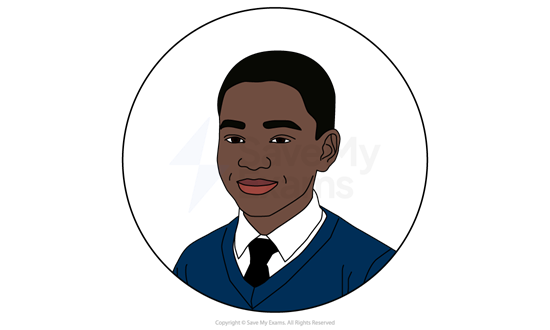
Harri is an 11-year-old boy who has recently moved to London from Ghana with his mother and his sister Lydia
He is both the narrator of the story, and its protagonist:
The book was written as a comment on the murder of Damilola Taylor, and Harri is used as a representation of him: a year older, an immigrant, the victim
Kelman presents Harri as an innocent, curious and kind young man
However, Harri is also presented as naive to many of the facets of life he is now faced with in his new home
Kelman has him use turns of phrase to illustrate his naivety, with “everybody agrees” repeated 11 times throughout the novel to reinforce often outlandish statements:
It is mostly said about things he has heard from others: “Fag Ash Lil killed her husband and ate him in a pie” is one such example
This shows his naivety, but also reinforces to the reader that these are not facts
We also see this in how he misunderstands adult concepts, especially of a sexual nature
While Harri does not feel the burden of immigration that his Mamma takes on, he still shows the limbo felt between an old home and a new environment:
He fails to understand the different type of churches in the UK, being used to his joyous church at home and feeling there is one god
Harri is the character most clearly shown to be swept up in the cycle of violence and death in the estate:
He starts and ends the book by telling us about the blood he can see, once the dead boy’s, later his own
By opposing the Dell Farm Crew, much like the dead boy did, he becomes their next victim
He also falls into classic traps of masculinity:
He feels he is the protector of his household, his gender being more important than his age
Harri is drawn to the power of the Dell Farm Crew, sometimes for good reasons (protecting his church) and sometimes bad (punishing Vilis)
Harri is consistently positioned as a figure of stark contrasts by Kelman:
He is the investigator of a death, then a victim
He is a good Christian boy, but is enticed by the gang
He believes the discriminatory statements about others, but then questions them internally:
Examples here are Altaf, a Somali boy he is told is a pirate, but finds he likes
The Muslim girl praying, who he cannot believe would be thinking of bombs, but clearly has internalised the opinions of others
The pigeon, even though others think pigeons are dirty
He is soft and kind, but shows signs of anger and violence to smaller boys
Kelman also presents Harri as outwardly comfortable and blasé with the death of the boy and with violence, but is subconsciously affected:
He has an obsession with solving the case, feeling a friend to the dead boy once he is dead
He has an almost deranged focus on the shade of red used in his painting
Lydia Opoku

Lydia is Harri’s older sister
She is two years ahead of Harri in school (Year 9)
Lydia is a typical teen and seems much more aware of the social structures of the family’s new home
She is friends with Miquita and Chanelle, and attends a local dance club
Harri and her have a typical brother/sister relationship, with some antagonism, but also a clear friendship
As the story goes on, Lydia’s realises the seriousness of their predicament much before Harri:
She destroys evidence for Miquita and the Dell Farm Crew
She allows Miquita to burn her as a threat to remain silent
She remains friends with Miquita when Chanelle is no longer part of the group
However, she finally stands up to Miquita when she sexually assaults Harri
Lydia appears to save her brother’s life towards the end when X-Fire rounds on Harri after finding the dead boy’s wallet in his pocket:
By filming the incident, and threatening to call the police, it gives Harri and Dean time to escape
She then walks to school with them the next day and appears happier in their company
The character of Lydia also shows us the struggle of being an immigrant:
After Miquita burns her, Lydia cuts up and then throws her dance costume off the balcony:
This is a metaphor for her lost innocence, the pieces falling symbolic of her innocence fading away
Miquita

Miquita is a friend of Lydia in her school year, and the girlfriend of Killa
Miquita is on the fringes of the Dell Farm Crew, but quickly pushed aside and quietly abused by Killa
Miquita is the only person who brings the dangers of outside into the Opoku family home:
Her presence is a symbol of how poverty can bring danger:
Had Mamma been able to work less, she would be home to protect her children from Miquita’s violent and aggressive behaviour
Miquita is comfortable with violence and shows a lack of respect for anyone who does not align with the Dell Farm Crew
She is another character lost in the cycle of violence:
This is clear in how she treats both Lydia and Chanelle, both of whom she physically attacks to protect Killa, and both are discarded in favour of the gang
She sees no better way to deal with the issues than violence
Equally, she is a victim of it, with burn marks left on her by Killa
She deflects her pain by pushing it on to others, a common behaviour in the story
Miquita is sexually aggressive towards Harri from the start, which contrasts directly with his inexperience:
Kelman may have pushed this characteristic to show both how young people are pushed into and misunderstand adult behaviours
It also may show how her closeness to the toxic masculinity of the Dell Farm Crew forces her to play up and rely on sexuality, as that is how she is seen and wanted by Killa
Her treatment by Killa may also explain her assault on Harri, with lessons she has learned in her life coloured by abuse
In the end, Miquita is left unwanted and rejected by Killa, and without either of the two female friends she had at the start of the story:
Through Miquita, Kelman may be trying to show us how the environment makes her disposable
Marcus “X-Fire” Johnson

X-Fire (pronounced Cross Fire) is in Year 11 at Harri’s school
He is the leader of the Dell Farm Crew
X-Fire tries to recruit Harri to the gang
Towards the end of the novel, he is ready to kill Harri, and would be a clear suspect in his murder
X-Fire is presented as a very typical leader of a gang:
He is happy to be nicer towards people he may want as part of the gang, but threatens others regularly and wields his power
When Harri eventually tells the reader about the time around the dead boy’s murder, we see that it is disrespect to X-Fire and Killa that got him killed:
What we are shown by Kelman is that a perceived slight is enough to warrant murder in their eyes
We see how X-Fire tries to lure Harri and other younger boys into crime, showing interest in them and offering them protection:
At one point, he tells the other boys in the gang to leave Harri alone
He is nicer to Harri until Harri refuses to join the gang one too many times, and then turns on him with threats of violence
X-Fire commits many crimes throughout the story, and is shown as a symbol of how bored and unprotected boys will lash out and commit crime without anything else to sustain or entertain them
His influence on Killa becomes apparent:
He is shown to have control over him
Jermaine “Killa” Bent
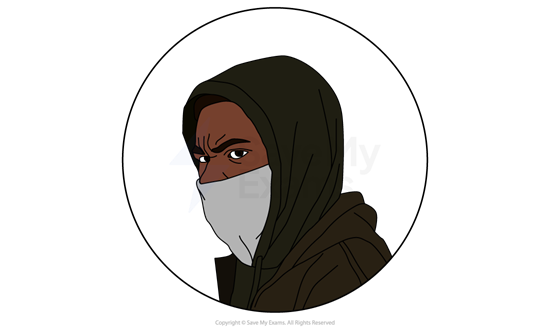
Killa is another member of the Dell Farm Crew who goes to Harri’s school
He appears to be second in command to X-Fire
He is also in Year 11
Harri wonders whether he is called Killa because of the amount of people he may have stabbed
Killa dates Miquita, but does not treat her well, including regularly burning her
Later in the story, it is revealed Killa was the one who murdered the dead boy
Throughout the novel, Killa is shown as more anxious around the murder of the dead boy:
We first meet Killa when X-Fire is mimicking stabbing Harri for the younger boys
Kelman shows us Killa not joining in and staying quiet, which signifies his guilt and discomfort
At the dead boy’s funeral, Killa falls off his bike in front of the funeral car:
Rather than showing the expected aggression that usually follows any embarrassment for these boys, Killa quickly gets back on his bike and rides off
When he goes around the back of the car, he nearly falls off again as he sees the flowers
This could be Kelman again symbolising his guilt:
Killa’s physical instability on the bike could represent the emotional instability he feels after the murder
Later on, when Miquita fights Chanelle to keep her silent, he is again quiet and then leaves, in contrast to the rest of the Dell Farm Crew, who are enjoying the fight
Towards the end of the novel, Killa is furious that Harri has his fingerprints, clearly fearing what could be done with them
Killa does not shy away from Dell Farm Crew activities
Killa is shown as quick to react emotionally to anything that could make him look weak, showing the insecurity, and resulting urge for violence, in the masculinity that we see from many in the story:
In May, we see him pull a screwdriver from his trousers, ready to stab Asbo, Terry Takeaway’s dog, because the dog jumped up and shocked him in front of others
He later smashes Harri’s binoculars when Harri is staring at him through them:
This could be Kelman showing us how uncomfortable Killa is under such focus because of his anxiety over the murder
We eventually find out that the reason the dead boy is killed is that he embarrassed Killa
Before the ending and Harri’s death, Killa finds the dead boy’s picture on Harri:
Killa intensely stares at it and then forcefully pushes Miquita away when she tries to check on him
He runs from the confrontation, almost crying after X-Fire sends him away
Later, he is seen staring at the fire at the playground, holding a piece of burnt wood and then walking away, with Harri noting how sad he seemed. This is the last we see of him
Killa is shown as violent and angry throughout, but also sad and lost:
He is a victim of his surroundings, swept up into violence and death, caught up in the cycle of expectations of masculinity, and has had his innocence taken from him by it all
The Pigeon
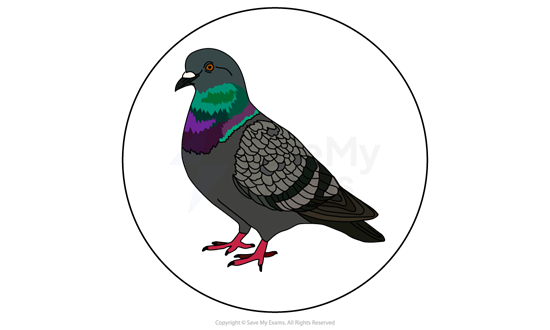
The pigeon is introduced early in the narrative, having flown into Harri’s apartment:
Harri then decides that this is his special pigeon
The pigeon becomes a second narrator, intervening at different moments to offer philosophical musings on various things, including:
Harri’s situation and his future
Human behaviour
The parallels between pigeons and people
As a character, the pigeon is placed as somewhat of a guardian angel for Harri, although one that states it cannot get directly involved:
It appears to be guiding Harri to a place beyond our world, but does not give specific details
The pigeon is often used to show a parallel or contrast to Harri’s life:
It is attacked by magpies, similar to Harri’s problems with the Dell Farm Crew
The narration from the pigeon is often filled with more complex sentences and vocabulary, suggesting more maturity than Harri
Similarly, the more thoughtful narration is often in contrast to Harri’s blunter and naive words
The pigeon, and Harri’s attachment to it, symbolises many of the themes that run through the text:
In talking to the pigeon, we see Harri’s innocence. In the end, he relies more on the pigeon for guidance than any adult:
In doing so, Kelman is showing us the strain the immigrant experience has on young people
Harri is removed from his father and mother by different circumstances forced by their immigration
Harri is fascinated by the pigeon’s ability to fly, and wants to be able to as well:
This symbolises Harri’s desire for freedom from his situation and the pressure of it
Equally, this could represent how the children in the estate are unable to spread their wings, both to grow to full potential, or just to escape
Harri’s fondness for the pigeon contrasts with how others consider pigeons as dirty birds:
This represents his tolerance and openness to the good in others
The pigeon is drawn on Auntie Sonia’s plaster cast by Harri after her injury, symbolising Harri’s hope that she can find freedom
It is presented that Harri and the pigeon can talk:
It is not clear whether this is in Harri’s head or whether the pigeon truly is conversing with him
However, the language, tone and philosophical musings seem beyond anything we hear from Harri
Other characters
Mamma
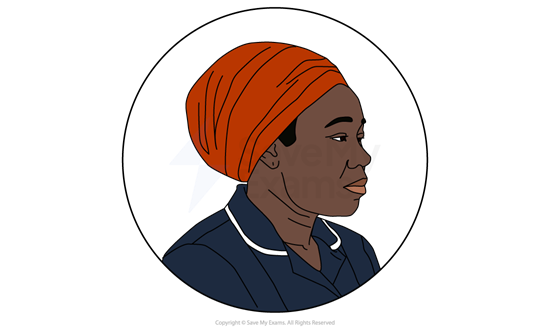
Harri and Lydia’s mother is only ever known to us as Mamma
She works as a midwife, working long shifts across day and night:
This leaves Harri at home with Lydia, and allows Miquita to misbehave in their house
Mamma is very religious and conservative in her views:
She is concerned about her children swearing or talking about anything of a sexual nature
She is a symbol of the immigrant struggle:
She is trying to build a new life in the UK with two of her children while her husband and baby daughter are both behind in Ghana, unable to afford to come over
She works hard, at all hours, desperate give her family a better life
At least in the UK, she is a single parent, and that is also representative of challenges faced in lower socio-economic areas
Mamma faces racism at work:
She is called a “fuzzy-wuzzy” who “just got off the boat” but protects Harri from its meaning
Harri misunderstands her religious spirit:
Harri believes she is happy when praying for dead children on the news, as she has taught Harri that religion and prayer is joyful
Dean

Dean is Harri’s best friend from his school year
Dean is white, and at times is treated differently by the Dell Farm Crew than Harri is because of this
Dean and Harri take it upon themselves to investigate the death of the dead boy
Dean gets teased at school for having ginger hair:
However, Harri doesn’t judge him on appearance, instead being impressed by his intelligence
Dean is not impressed by the Dell Farm Crew, although this could be because they show no interest in him
He calls the Dell Farm Crew “numpties” to Harri, asking him not to join the gang:
This shows his more innocent character
This does not make him immune to bad behaviour, however:
He intimidates smaller children with more aggressive language later in the novel, although he at least creates rules for safety of the kids when jumping on the mattress
Terry Takeaway
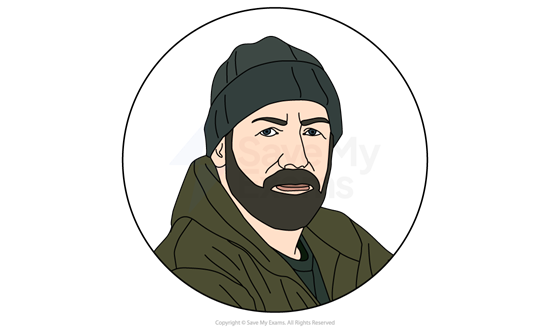
Terry Takeaway is a local man, who we are told by Harri got this nickname as he steals frequently:
He often tries to sell stolen goods to Harri
He used to be in the army, but became an alcoholic
Terry is always seen with his dog Asbo, who appears to be ironically named:
An Asbo is a legal order designed to prevent antisocial behavior that causes harassment, alarm, or distress to others
However, this Asbo is a sweet dog who behaves without aggression
Although he is involved in crime, he is often the closest thing Harri has to a male role model:
He is good-natured, funny and treats Harri with respect
When Killa threatens Asbo with a screwdriver, Terry is neither intimidated nor aggressive, but stands up to both Killa and X-Fire, who back down:
He then walks Harri and Dean home
Harri overlooks Terry’s crimes:
Kelman could be using Terry to show how few people show an interest and kindness to the youth in the area, so even a questionable character like Terry is seen as a good guy
Terry also signifies a soldier who is let down by society and abandoned in poverty, showing another way in which society ignores people
Auntie Sonia
Auntie Sonia is Mamma’s sister
She lives with Julius, who we learn helped Harri and his family make it over from Ghana
It is also made clear that Julius is involved in crime, and is a violent man, including towards Sonia:
Sonia would like to leave, but feels that Julius would not let her:
She admits this after she is left in plaster cast thanks to injuries she claims are accidents, but are heavily implied to be caused by Julius
Her reliance on Julius, a man she knows mistreats her, and her fear of losing him could be used by Kelman to represent the desperate situations some immigrants get stuck in as they cling to a new life:
Equally, this could represent how women in poverty sometimes have to compromise their safety for a home
Sonia is an undocumented citizen
She burns her fingerprints off so that she is harder to track and can avoid deportation:
At the end of the story, her status is still up in the air, but it is implied she is planning to leave London, maybe the the UK altogether
While she has clearly moved from abroad, she is much more used to life in the UK than members of Harri’s immediate family
She is generous to the kids, but her gifts represent the lure of material possessions in modern society:
This is highlighted by how excited Lydia gets when receiving the phone she asked Sonia to get her
Julius
Julius is Auntie Sonia’s partner
It is made clear that he is involved in crime and violence:
He carries his bat “Persuader” with him everywhere
Julius impresses Harri with his flash lifestyle, with money and an expensive car
It is in this car that Julius took the family to their new flat, implying he arranged their place to live
While clearly a violent and angry man, he seems wearied by his life, telling Harri to “stay good for as long as you can”:
Although it can be argued that he is making it worse, he is still a man stuck in the cycle of violence
In June, Lydia tells Harri that Julius sells fake visas:
We also hear that Mamma pays Julius occasionally, implying that they might be in the country on one of Julius’ fake visas
Julius represents the risk and danger that immigrants and those in poverty can face:
The family’s association with him is not by choice, and Mamma is never comfortable around Julius, especially because of his treatment of Sonia:
However, she shows no concern to Julius in person, showing how many immigrants have to accept mistreatment and risk in order to get by
The dead boy
The dead boy is never named, but his murder scene starts the story
He was in Year 11 and was killed outside of Chicken Joe’s
Harri describes him loosely as a friend:
However, it is clear in the way he speaks about him and remembers him that they were not friends
Harri questions why the dead boy was stabbed for food, but later remembers the confrontation that led to Killa killing him:
There are two reasons Kelman may have made this choice:
To show that aggressive confrontations are barely worth remembering, as they are that common
Or that Harri has suppressed the memory as it is linked to trauma and anxiety about the death of children in the area
That the dead boy is never named may also be a comment on how society treats victims of murder in areas like Dell Farm as a statistic:
Making these people nameless and faceless makes it easier for us to ignore
Jordan
Jordan is Harri’s other best friend, although that changes as the story goes on
Jordan has been expelled from school:
He is very different to Harri in that he misbehaves and is rude
Jordan lives in Copenhagen House, as does Harri
Jordan and Dean contrast each other as Harri’s two best friends:
Dean represents safety, while Jordan is happier in risk and criminality
Jordan pushes Harri into things like smashing bottles and throwing stones at a bus, which is what causes Mamma to ban Harri from seeing him:
From here, they fall out
Jordan has started doing tasks for the Dell Farm Crew, stealing for them for protection
Harri antagonises Jordan near the end of the story, after their falling out, knocking on his door and promising him a go with his remote-controlled car, then leaving:
After this, the word “DEAD” is scratched into the door of Harri and his family’s apartment, which Harri thinks was Jordan
Jordan is the other suspect for us in the killing of Harri
Poppy Morgan
Poppy is a girl in Harri’s school year
She is a white girl with blonde hair:
Harri affectionately calls her “my yellow”
Poopy becomes Harri’s girlfriend
Poppy is sweet and kind to Harri, and they have a typical relationship for their age:
They hold hands
On the last day of school and the day of Harri’s death, they kiss for the first time
Poppy contrasts to Miquita, showing herself as sweet and innocent
Harri and Poppy’s relationship emphasises how sweet and innocent Harri still is
Sources
Kelman, S. (2011). Pigeon English. Bloomsbury

Unlock more, it's free!
Did this page help you?